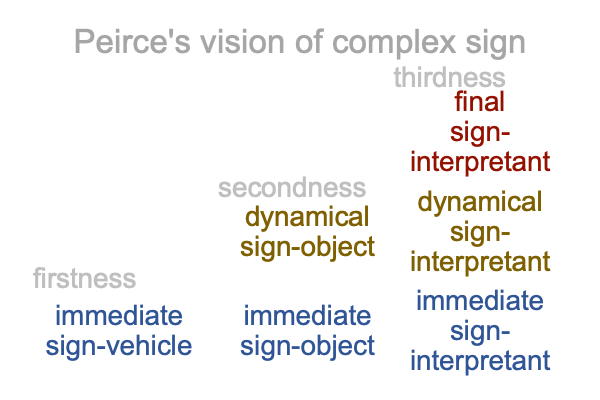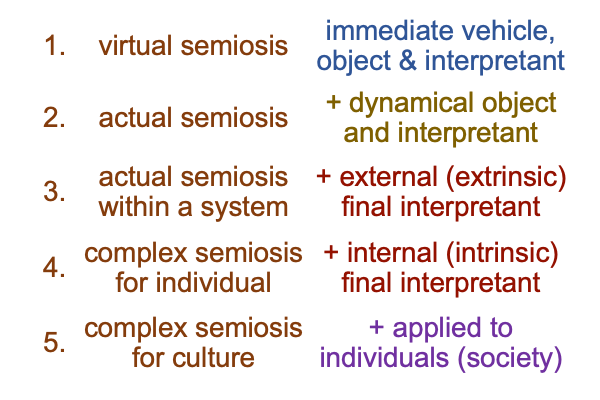0080 This is the third blog in a series.
The first blog, posted from May 15 through 18, 2023 at www.raziemah.com, performed a cursory examination of Brian Kemple’s Book (2019) The Intersection of Semiotics and Phenomenology: Peirce and Heidegger in Dialogue (Walter de Gruyter, Boston/Berlin). The book is volume twenty in the Semiotics, Communication and Cognition series, edited by Paul Cobley and Kalevi Kull.
The second blog precedes this blog, depending on how one defines, “proceeds”, and covers appendix 1.1.
At present, I have appendix 1.2 of Kemple’s book before me.
0081 Peirce’s vision of a complex sign-relation contains one sign-vehicle, two sign-objects and three sign-interpretants. Altogether, there are six elements.

0082 Kemple presents five different possible configurations of semiosic structure. He calls this sequence, “the semiotic ladder”. Here is a table of the five rungs.

Clearly, the semiotic ladder offers a variation of Peirce’s vision of the complex sign-relation.
0083 I ask, “How would I translate the semiotic ladder into category-based nested forms?”
Peirce’s formulation of a complex sign-relation starts with a single sign-vehicle. The immediate sign-vehicle triggers an immediate sign-object and immediate sign-interpretant. Then, a dynamical sign-object and dynamical sign-interpretant follow. Then, if the sign-vehicle repeats and the dynamical interpretant becomes a habit, that habit is a final interpretant.
0084 In contrast, a three-level interscope is a category-based nested form composed of category-based nested forms. Each of three levels (contenta, situationb and perspectivec) contains a nested form with three elements (potential1, actuality2 and normal context3). There are nine elements altogether.
So, is there a way to mesh a paradigm with six elements with one with nine?
0085 Well, yes and no.
Yes, category-based nested formulations of signs are developed in several of Razie Mah’s e-works, including Comments on John Deely’s Book (1994) New Beginnings and Comments on Sasha Newell’s Article (2018) “The Affectiveness of Symbols”.
No, the formulations do not quite match Peirce’s paradigm.
0086 Nevertheless, an attempt to explain Peirce’s paradigm in terms of the three-level interscope may prove insightful, even though it may not be fully satisfying.
To this I attend, using the example of a landslide.
